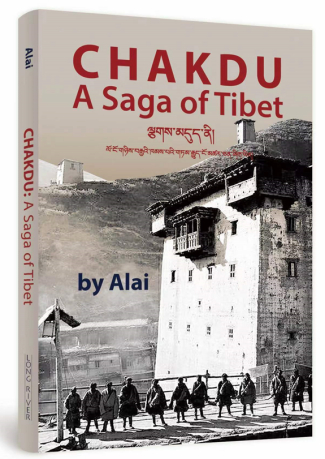
Chakdu: A Saga of Tibet
Author: Alai
Paperback, 328 pages
Published by Long River Press
Historically, Chakdu was a tiny place in Kham, one of the three traditional Tibetan-inhabited regions. Today, it is known as Xinlong, a county in Garze Tibetan Autonomous Prefecture, Sichuan Province, which holds a strategic position on the main transportation route from Sichuan into Tibet. The Khampas, people of Kham, are known for their fighting fitness, and the Chakdu people are the fittest of the fit. Locals would proudly say, “The Chakdu people are made of iron.”
The author Alai is a household name with numerous works of fiction and nonfiction to his credit, and a winner of the Mao Dun Literature Prize, one of China’s top literary awards. Born in the Tibetan area of Sichuan, Alai gained his reputation with his novel Red Poppies, known for its lyrical, poetic language, and deep grounding in Tibetan culture and society.
Chakdu: A Saga of Tibet, written after years of research, offers a panoramic view of modern Tibet history. Clashes of cultures and ethnic groups occasionally happen but the problem is that some people tend to regard any problem related to Tibet as a “failure” of Han-Tibetan relations.
This book seeks to address the misunderstandings and give readers a true picture of the interactions between the Han and Tibetan people through the 20th century into the 21st. Alai skillfully reconstructs the wars, conflicts, and vicissitudes of the locality over the past 200 years. The result is a fascinating micro-history of the region: its sagas, legends, and everyday life.
The ten chapters trace the past of Chakdu, going beyond folklores to cover real history. The events they chronicle have all occurred and involved many historical personages, including Emperor Daoguang of the Qing Dynasty (1644-1911) and his minister Qishan.
Anyone moderately acquainted with Chinese history will recall Qishan, the capitulationist imperial commissioner during the First Opium War (1839-1842). Qishan was cashiered by Emperor Daoguang for approaching the British and signing unequal treaties with them in Guangzhou. However, he was reinstated as grand minister resident of Tibet and later appointed governor-general of Sichuan.
Qishan’s trip from Tibet to his new post in Sichuan was impeded by a group of Tibetan “jiaba” (bandits) who held the thoroughfare linking Sichuan and Tibet in today’s Garze. Qishan advocated action to suppress them and the Qing court collaborated with the Tibetan local administration to overthrow the separatist regime, leaving a series of legendary stories in history.
Today, it takes less than a day to drive from the Kangding Airport in Garze to Xinlong County. The once isolated towns and villages are connected by paved roads.
Tourism is being developed, the resources being the mountains and gorges that the Qing troops had found insurmountable in the past. The once formidable stockades and fortifications are also tourist attractions, with the passage of time having given them an archaic charm. The culture of the fierce Khampas is part of the explorations as well.
In today’s Xinlong, the farmers mostly wear modern clothing. If a man wearing traditional Tibetan clothes and sporting a plait threaded with red strips comes into view, your local guide will nudge you and say: “Look, here comes a real Khampa hunk!”
In writing this book, the author has relied on two kinds of materials: the Qing histories and archives, and the records by native intellectuals. The native historical sources are of great value in that they stand independent of the official narrative. As the author points out, Chakdu is kept alive by and among the local people in the form of oral history or storytelling. Many vivid details are preserved intact in the stories passed from mouth to mouth.
Another characteristic of folk literature is the polyphonic narrative where multiple viewpoints and discourses on the same event exist, and they have all been presented in the book. Besides, the author explored the villages and battlefields to get a sense of the place in which each story is set. It turned out to be a very rewarding tour, as it helped the author to find more connections between the past and the present.
History is a prism through which we can contemplate the present. Chakdu is a small area but its past holds a pertinent lesson in contemporary times. After all, “all history is contemporary history.”